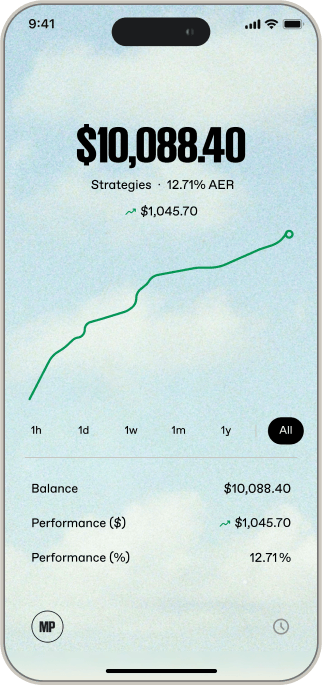Your pocket hedge fund.
hedge fund.
8.84% AER
8.84% AER

Make money like 1, 2, 3:
Step 1
Create an account in less than 2 minutes.
Step 2
Deposit funds with Apple or Google Pay, bank or blockchain transfer. No fees. It’s that simple.
Step 3
Invest in Strategies™. That’s it, you’re already earning 8.84% AER*. Paid daily.
*Variable. This is the annualised return over the last 90 days.
What’s in it for you.
#01
Exceptional returns
Strategies™ is currently returning 8.84%* AER.
#02
Daily compounding
Returns on your returns that make your long-term earnings exponential.
#03
No minimum
Unlike traditional hedge funds, Strategies™ lets you invest as little as you like.
#04
Withdraw any time
Forget about locking in your funds for long periods. Stay liquid.
*Variable. This is the annualised return over the last 90 days.
But wait, how is this possible?
Usually, investing involves one key element: prediction. It tries to forecast market movements. Highs and lows.
But here’s the thing. Predictions may or may not come true. And they often don’t. That’s why most investments fail.
Neverless Strategies™ makes money in real time with real data. No fingers crossed or crystal balls. Our algorithm scans the live markets for inefficiencies and profits from them. It detects small price differences of the same asset in different venues. Or quotes to both buyers and sellers at different prices. Trades all in nanoseconds. And repeats.
The result? Consistent returns at lower risks, because it doesn’t matter how the markets will move. Technically, it’s market-neutral.
So whatever the prospect may be, the future is irrelevant. Strategies™ makes money in the now.
Maybe so should you. Not investment advice.

The proof is in the pudding.
Our Strategies™ have never failed to perform. Past performance is not a promise of future results.
9.66%
AER
12.11%
AER
9.47%
AER
8.53%
AER
9.29%
AER
9.58%
AER
8.21%
AER
8.3%
AER
10.66%
AER
10.28%
AER
8.41%
AER
8.41%
AER
Jan
Feb
Mar
Apr
May
Jun
Jul
Aug
Sep
Oct
Nov
Dec
